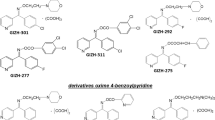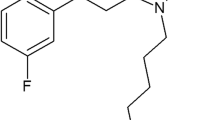Summary.
5-Fluoroindole-2-carboxylic acid, an antagonist of the glycine site within the NMDA receptor complex, administered intraperitoneally in doses of 150 and 200 mg/kg, 120 min before electroconvulsions, significantly raised the convulsive threshold from 6.8 to 7.9 and 8.3 mA, respectively. At lower doses, it did not influence the threshold. However, lethality was observed 24h after administration of the threshold-elevating doses of this glycine site antagonist.
5-Fluoroindole-2-carboxylic acid (100 mg/kg), applied together with carbamazepine, valproate or phenobarbital, significantly reduced their ED50 values against maximal electroshock – from 13.9 to 7.5 mg/kg, from 291 to 242 mg/kg, and from 18.6 to 11.1 mg/kg, respectively. At the dose of 50 mg/kg, it also potentiated the protective activity of carbamazepine. However, 5-fluoroindole-2-carboxylic acid, up to 100 mg/kg, did not affect the anticonvulsive activity of diphenylhydantoin.
When applied at doses equal to their ED50 values against maximal electroshock-induced convulsions, carbamazepine (13.9 mg/kg), phenobarbital (18.6 mg/kg) and valproate (291 mg/kg) did not affect the motor performance of mice in the chimney test. 5-Fluoroindole-2-carboxylic acid (100 mg/kg) produced a significant motor impairment, at 50 mg/kg it did not affect the motor performance. The combined treatment of 5-fluoroindole-2-carboxylic acid (100 mg/kg) with carbamazepine, phenobarbital or valproate, providing a 50% protection against maximal electroshock, resulted in motor impairment. Only the combination of 5-fluoroindole-2-carboxylic acid (50 mg/kg) with carbamazepine (8.6 mg/kg) did not significantly influence this parameter.
Almost all of the antiepileptic drugs studied, when administered at doses equal to their ED50 values against maximal electroshock, did not influence retention in the passive avoidance task, which is a measure of long-term memory. Only valproate (291 mg/kg) worsened long-term memory. The combined treatment of 5-fluoroindole-2-carboxylic acid (100 mg/kg) with carbamazepine or phenobarbital, providing a 50% protection against maximal electroshock, did not affect the retention. The combination of 5-fluoroindole-2-carboxylic acid (100 mg/kg) with valproate (242 mg/kg) caused a significant impairment of long-term memory and mortality of 50% of animals 24 h following the administration. The results suggest that the blockade of the strychnine-insensitive glycine site may lead to an enhancement of the protective activity of some conventional antiepileptic drugs, which is associated with pronounced side-effects and lethality in some cases.
Similar content being viewed by others
Author information
Authors and Affiliations
Additional information
Accepted January 9, 1998; received July 28, 1997
Rights and permissions
About this article
Cite this article
Kamiński, R., Przywara, B., Gasior, M. et al. Effect of 5-fluoroindole-2-carboxylic acid (an antagonist of the NMDA receptor-associated glycine site) on the anticonvulsive activity of conventional antiepileptic drugs. J Neural Transm 105, 133–146 (1998). https://doi.org/10.1007/s007020050043
Issue Date:
DOI: https://doi.org/10.1007/s007020050043




